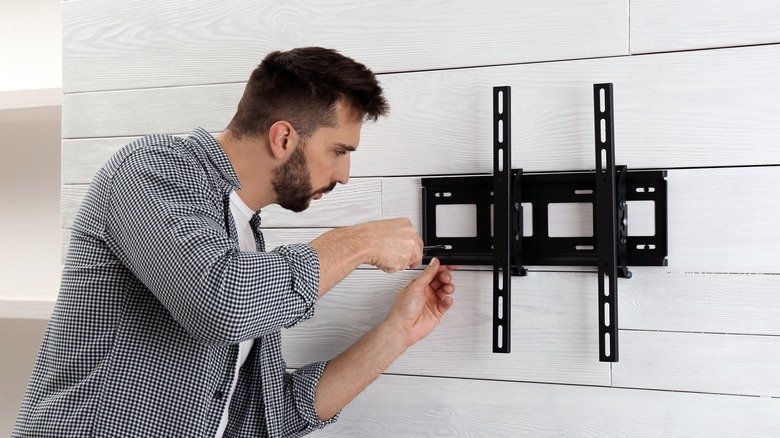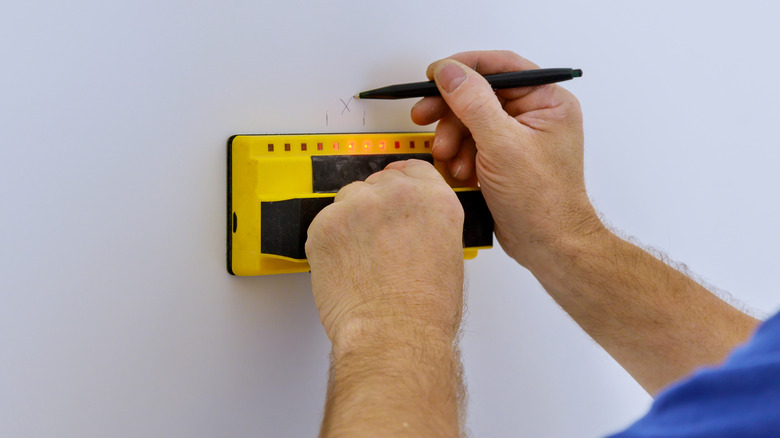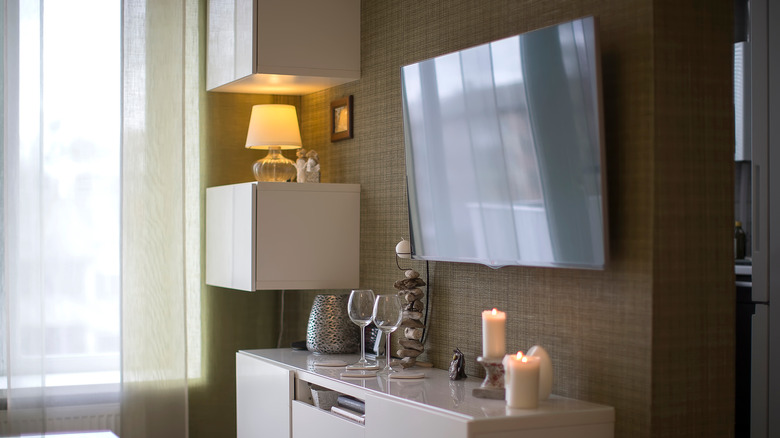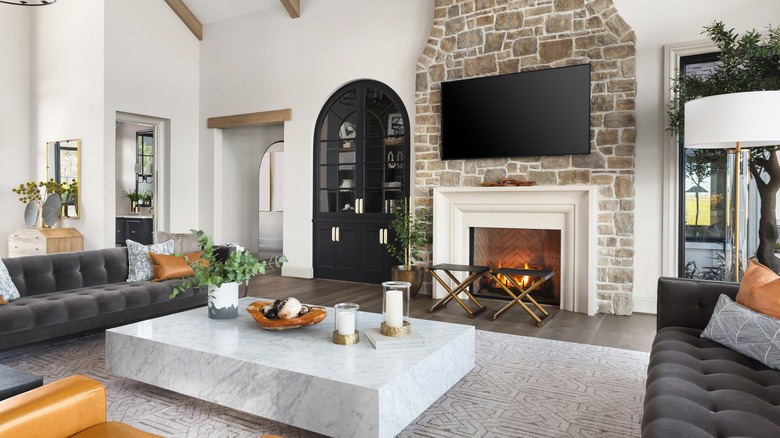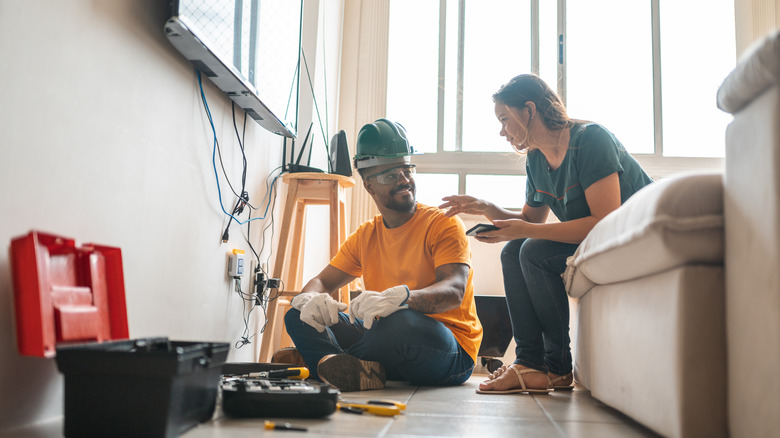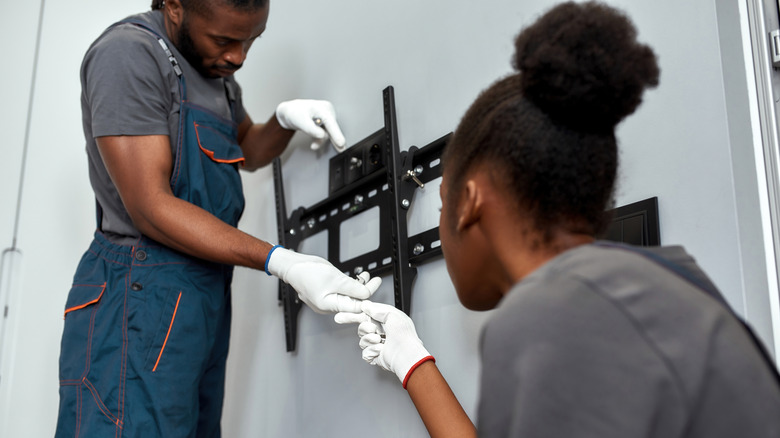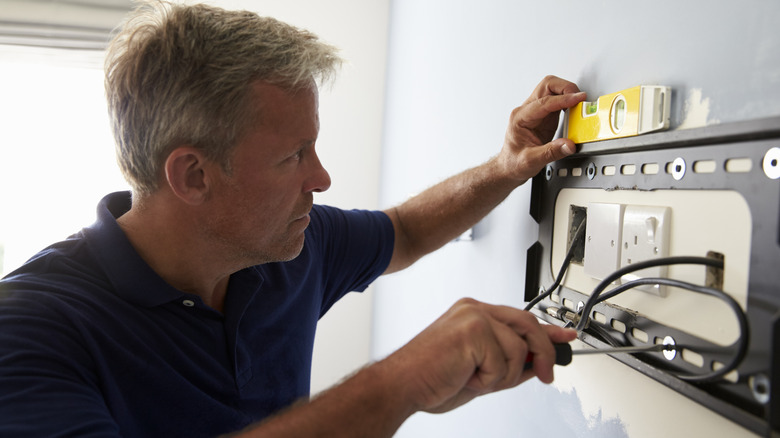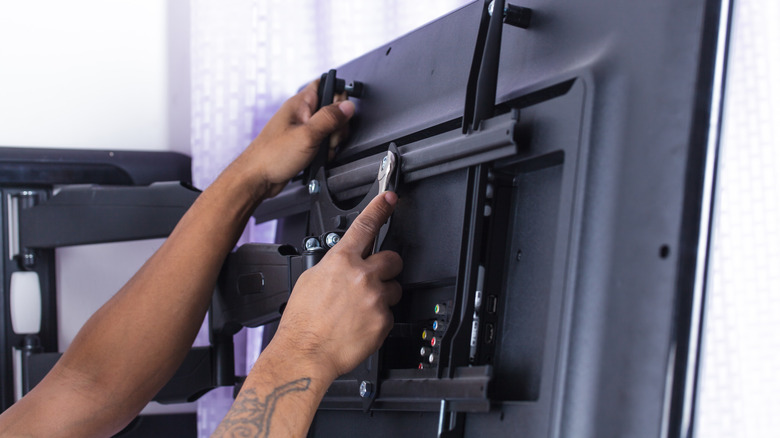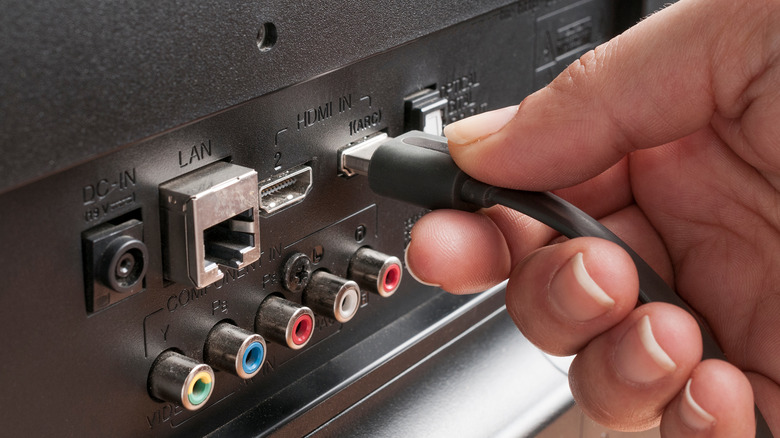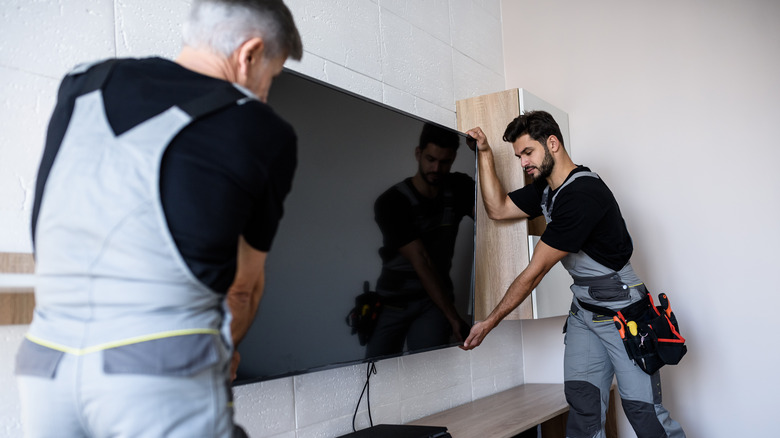Avoid Making These Massive Mistakes When Mounting Your TV
We may receive a commission on purchases made from links.
Maybe you've just purchased a new TV or you've moved to a new home and you're excited to set up the space. However, that doesn't mean that you should rush to get your TV mounted to the wall. Sure, the installation offers several benefits. It can give your living space a more streamlined and less cluttered appearance. And, if you have young children or pets — or even live in an earthquake-prone area — mounting your television can also prevent it from tipping over and getting damaged. However, before you run off to buy a mount and start putting the TV up on the wall, keep in mind that people often make several mistakes when completing this task.
Steering clear of these errors can help you avoid the negative consequences that go with them. These can range from inconveniences like uncomfortable viewing to costly mistakes like damaging the television. Or, you might just miss a crucial step, leaving your space looking messy. So, here are the mistakes to avoid when setting up your new TV-watching experience.
Positioning the TV too high or too low on the wall
One of the biggest mistakes you can make when mounting a TV is not positioning it at the right level on the wall. If the TV is too low, it is going to be difficult to see from where you're sitting. Place it too high, and you'll have to sit with your neck at an uncomfortable angle as you watch it. In most cases, positioning the middle of the screen about 42 inches off the floor should place the TV at eye level and help you avoid having to contort your neck to watch it.
However, while this is a general rule, there will be times when you'll want to stray from these recommendations. For example, if the seats in the room are higher than the standard height of a couch, like bar height stools, you might want to move the TV a little farther up the wall. In this case, you'll want the middle of the screen to be about the eye level of seated viewers. If you have a few seating options, an adjustable mount can allow you to tilt the screen to the best angle depending on where you're sitting.
Another reason to consider moving the screen up a few inches is if your room is set up for multiple rows of people to watch at the same time, such as with a home theater. If someone is sitting directly in front of someone else, they could obscure their view of the screen. Raising it a little can help ensure that everyone will be able to see it.
Not installing it into wooden studs
TVs are heavy. Whenever you're putting one up on the wall, it is essential to mount it into the studs. Hollow wall anchors will not offer sufficient support, and your TV is likely going to come off of the wall, potentially injuring someone or damaging nearby furniture. Start by using your stud finder to locate the studs in the wall. Then, mark their location with some painter's tape or a pencil.
Many TV mounts will require two studs, though some may be designed for use with just a single stud. After measuring to find the correct height, you can drill the pilot holes into the studs. When drilling the second hole, it is important to use a level to ensure that the two holes line up. If you have a brick wall, you'll need to use masonry anchors to secure the television to the wall.
Not accounting for sunlight and glare when choosing the location
The last thing you want to do is to get your TV mounted only to regret where you decided to place it. One potential problem is the screen being difficult to see because of the glare caused by sunlight coming into the room. To minimize this, avoid putting your TV across from windows that face the west. It's also a good idea to hold the unit in the place you plan to hang it a few times to simulate viewing. Doing this at various times of day will allow you to see how changing light conditions might affect your picture.
Another tip to prevent glare from ruining your viewing experience is to choose a mount that allows you to tilt the TV. This way, if there is too much sunlight reflecting off the screen, you can change the angle slightly to make it easier to see. Investing in some adjustable blinds or shades can also help you control how much light enters the room when you're trying to watch something.
Mounting your television above the fireplace
Even though many people do it, mounting a TV above a fireplace is not a good idea for several reasons. The first is that the screen will likely end up too high to provide a comfortable viewing angle. Remember, the ideal height for the center of the screen is about 42 inches. If you want to place the television above the fireplace, it will likely end up much higher than this. Also, the picture quality of LCD televisions isn't going to look right if it isn't viewed on-axis. So, if you do hang your screen over the fireplace, you'll want a mount that lets you tilt the screen downward towards the viewing area.
Beyond the discomfort and negative viewing experience that you may experience if you mount your television over a fireplace, this location isn't a good choice for the electronic device itself. The heat generated from a fire can make the TV warmer, which can decrease its usable lifespan. Ash and soot may also get into the television and damage its various components.
Not having a plan for cable management
One appeal of mounting a television on the wall is that it can help to declutter your living space and give it a more streamlined appearance. However, if you're left with wires and cables all up and down the wall, your goal of a tidier living space isn't going to be realized. To help you create the look you're going for, you should also take how you're going to hide wires and cables into consideration before starting the installation process.
Fortunately, there are different ideas and systems that can help you keep cords and wires from cluttering your space. One option is to use an in-wall cable management system. This type of system will make it possible to run all the power cords and cable connections down through the wall, keeping them out of sight. If you don't want to run the wires through the wall, you can also use a cord cover to conceal the track running down to the floor. You could even paint over the cord cover so that it will match the color of your walls.
Trying to mount the TV by yourself
Mounting a television is not a one-person job. TVs are heavy; as a reference point, a 65-inch screen can weigh up to 75 pounds. If you're trying to install a large TV, the screen is going to be even heavier. Beyond their weight, screens are also large, awkward to hold, and easily damaged.
When you take all of these aspects into account, it's clear that you should always work with another person when you're attempting to mount a television. It is the safest option and will help prevent you from dropping the TV, cracking its screen, or interfering with the function of any of the components. Plus, they can help you make sure that the television is properly lined up with the mount for a much easier installation. They'll also be there to help with double-checking measurements and placement, drilling holes, and just making sure that the installation goes off without a hitch.
Not using a level to keep the bracket straight
Another mistake that many people use is eyeballing the straightness of the bracket. This is not a good idea because if the holes for the arms on the mount are not even, the TV will not be straight. To avoid this problem, always use a level to make sure that both of the holes you're going to drill into the wall are at the same height. After using the level, make pencil marks over the studs at the spot you'll want to drill.
Some manufacturers integrate a level into the design of the mounts to help simplify the process. If yours doesn't include such a feature, you can use any standard level. This is another time when it will be helpful to have a partner working with you. One person can hold the level in place while the other marks where the drill holes should go.
Not choosing the right type of mount for your space
Before picking up a TV mount at the store or purchasing one online, it is important that you choose the right type. First, you'll want to consider where you're planning to place the TV and where you and others will be sitting to watch it. You should also consider other features of the room, such as the placement of the windows, whether people may watch the television from different areas of the room, and any other relevant details.
Once you've found the best spot for your TV, you'll be able to determine whether you want a fixed mount or one that can swivel or tilt. You could also consider a full motion mount with an articulated swing arm that will make it possible to angle the television, tilt it, or even pull it away from the wall. And before buying, double-check that the mount is suitable for your TV's screen size and type.
Not adding some additional cables
Picture this: it's only been a month since you mounted your television to the wall. You've already taken the time to organize all of the cables and hide them inside the wall. Then, your partner suddenly tells you they've decided to purchase a new speaker system for the space. The downside? More HDMI cables are needed to connect the speakers to the TV.
Instead of dealing with the frustration of moving everything around and trying to run additional cables through the wall, plan ahead to make life easier for your future self. While you're running the existing cords and cables through the wall or cord cover, send a few additional HDMI cables down as well. This way, they'll be available for use whenever you need them for a new speaker system, game console, or any other devices you want to hook up to your TV.
Not hiring a professional if you're uncomfortable with DIY
While mounting a television can be a DIY project, it isn't one that everyone will be comfortable with. As mentioned earlier, TVs are heavy and easy to damage. If you don't have anyone to help you with the mounting process, it can be an even more daunting situation. Moreover, there are several tools necessary to mount the screen, including a power drill, stud finder, level, measuring tape, and socket wrench. If you don't already own these tools — or aren't fully confident in how to use them properly — it's going to make the task even more difficult.
If you don't feel completely confident in mounting your television or simply don't have the time to commit to the job, you can hire a professional to help you. Someone who is trained and experienced should be able to tackle the job with ease and help you get the TV exactly where you want it. A professional will also be knowledgeable about cord management and can help you come up with the right system to keep cables under control.
